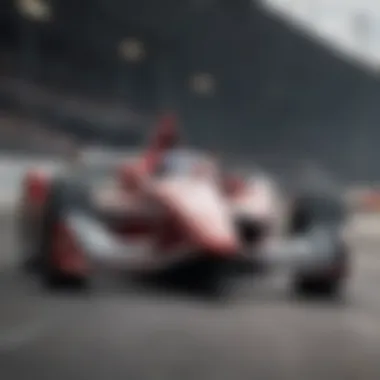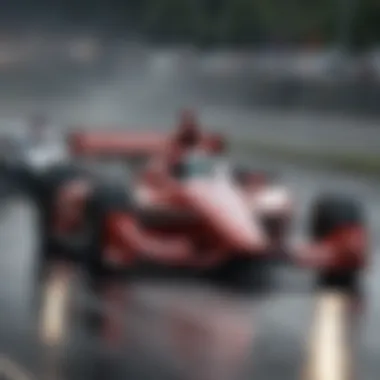The Evolution and Impact of IndyCar Cars in Modern Motorsport


Intro
IndyCar racing holds a revered status in the motorsport arena. The evolution of IndyCar cars is a direct reflection of technical innovation and engineering excellence. In the quest for pure performance, these vehicles have pushed the boundaries of what is possible in racing. Understanding their journey and developments is key to appreciating their impact not just on the racetrack, but across the automotive industry.
This article will unravel the key facets of IndyCar cars, examining historical contexts, technical specifications, and the historical impact these machines have made on motorsport as a whole.
Car Reviews
Overview of the Vehicle
IndyCar vehicles are built for speed, aerodynamics, and performance. Each year, manufacturers like Dallara, Chevrolet, and Honda play a vital role in producing cars that adhere to rigorous regulations while ensuring a competitive edge. The current generation of IndyCar is designed to handle various types of tracks, from ovals to road courses, showcasing their versatility.
Performance Analysis
Performance in IndyCar is quantified by metrics that integrate acceleration, handling, and braking. A standard IndyCar chassis can reach speeds of over 230 miles per hour. The Honda and Chevrolet engines, averaging around 700 horsepower, demonstrate incredible capability.
"Performance in IndyCar reflects decades of refinement and research into aerodynamic efficiency and grip."
In-depth analyses of race data reveal critical insights into how individual vehicles stack up against one another, comprising various factors like tire performance and pit strategies. Consistency in performance is pivotal during races, affecting not just pole positions but also overall race outcomes.
Design and Interior Features
IndyCar cars favor aerodynamic designs, often featuring streamlined bodies that reduce drag. Interior specifications tend to prioritize function over luxury. Cockpits are equipped with essential telemetry and communication systems, ensuring drivers can obtain real-time feedback.
Safety Ratings and Specifications
Safety in IndyCar racing is paramount. The use of advanced materials in crash structures, external barriers, and the implementation of the halo device exemplify this focus. Regulatory standards govern crash tests and safety equipment to provide maximum protection to drivers.
Value for Money
While exchanging ownership of an IndyCar is uncommon, the cost associated with developing these vehicles is extensive. Investments made by teams often counterbalance viewership and sponsorship revenues. However, the recognition gained through competition often elevates a team's branding beyond monetary measure.
As we explore further, it becomes apparent that the complexity and significance of IndyCar vehicles rest beyond mere specifications. Their implications resonate through technological advancements influencing consumer vehicles and future innovations in the automotive landscape.
Prolusion to IndyCar Cars
The world of motorsport has always displayed dynamism, and at its heart is IndyCar racing. This section explores crucial elements of IndyCar cars that shape this competition while detailing their importance through both history and technology. Recognizing IndyCars gives enthusiasts insight into the evolution of racing mechanics and how they inform the contemporary automotive industry.
Defining IndyCar: A Brief Overview
IndyCar refers to a style of auto racing that showcases open-wheel cars, designed primarily for high-speed competition. This racing format emerged prominently in the United States, gaining global attention through flagship events like the Indianapolis 500. At the core of IndyCar racing are performance, innovation, and competitive spirit, making it a unique discipline within the motorsport realm.
These cars are constructed to adhere to specified regulations while showcasing cutting-edge engineering. Each model presents advanced aerodynamics, optimized tire usage, and intricate suspension systems, reflecting a higher overall standard of performance that appeals both to professional racers and automotive enthusiasts.
Historical Context of IndyCar Racing
The origin of IndyCar racing dates back to the early 20th century. The inaugural Indianapolis 500 took place in 1911, marking the rise of a format that would forever change motorsport significance. Through the decades, the rules have evolved, and advancements in technological capabilities have provided insight into what can be achieved with racing machines.
Examining the historical context of IndyCar reveals its adaptation to cultural and technological shifts. The response to an increasing focus on safety, competition formats, and consumer interest has played a crucial role in its evolution.
- Early cars were primitive by today’s standards but established competitive foundations.
- Post-World War II, engineering innovations transformed car designs significantly, leading to enhanced performances.
- Challenging eras like the 1970s and late 1980s demonstrated the sport's resiliency and determination to pioneer cutting-edge practices.
In short, embracing the evolution of IndyCars allows individuals appreciating both the art and the science behind racing cars.
Technical Specifications of IndyCar Cars
Understanding the technical specifications of IndyCar cars is crucial for grasping the essence of modern motorsport. These specifications show how advance engineering meets racing demands, making each car not just a vehicle but a finely-tuned machine designed for excellence on the track.


Both performance and safety are vital when it comes to these specifications. The converging factors of aerodynamics, engine design, and materials used reflect the precision and innovation in the world of IndyCar racing. Knowing these elements can aid enthusiasts in appreciating the complexity inherent in this realm, and can also attract potential car buyers interested in speed and technology.
Engine Designs and Performance
One of the most critical elements in the specifications of IndyCar vehicles is their engine design. IndyCar cars are powered by turbocharged V6 engines, specifically designed for high performance. An engine must balance power and efficiency, delivering maximum horsepower while ensuring reliability over long races. The limits of heat displacement and fuel efficiency also promote innovation. For example:
- Horsepower: Vaults to over 700 hp during races.
- Turbocharging: Enhances acceleration without compromising weight.
- Fuel Type: Primarily runs on E85 ethanol, emphasizing sustainability.
Each component contributes to the car's overall speed while maintaining safety standards. The evolution from naturally aspirated engines highlights the drive to adapt and push technological boundaries. Consequently, performance is not merely a function of power output but also of durability in demanding conditions.
Chassis and Aerodynamics
A great deal of attention goes to the chassis in an IndyCar. It serves more than just structural support. Design and materials create a balance between strength and weight, urging teams to maximize performance through optimized aerodynamics. The chassis predominantly utilized is the Dallara IR18, which features:
- Curb Weight: 1,600 pounds.
- Width and Length: Standardized dimensions culminate in predictability and consistency.
Aerodynamics play a sustaining role as well, determining how well the vehicle cuts through air resistance. Enhanced airflow means faster lap times. Techniques like hydrodynamic simulations and wind tunnel testing are common practices.
Tires and Suspension Systems
The tires and suspension systems play a pivotal function in the handling and stability of IndyCar vehicles. The tires are specially formulated to provide thermal stability and excellent grip on different track surfaces. Options of softer vs. harder compounds can greatly affect strategy over race distance, as well. Notably:
- Tire Composition: Designed to optimize contact and reduce wear.
- Suspension: Innovative designs such as push-rod suspension enhance control at high speeds, giving drivers confidence.
The integration of technology within suspension setups, including active suspension systems, allows for adjustments in real-time, improving responsiveness to track conditions.
The Role of Innovation in IndyCar
The evolution of IndyCar racing cannot be divorced from the context of innovation. This motorsport series has consistently pushed boundaries in performance and technology. Innovations in IndyCar serve not just to enhance racing spectacle, but also provide practical insights for the broader automotive industry.
Technological Advancements in Racing
IndyCar has seen remarkable technological advancements over the years. Notable is the ongoing improvement of engine technology. Current engines, such as the Chevrolet and Honda units, are designed to deliver higher horsepower while managing fuel efficiency. These modifications not only allow for enhanced speeds, but they sitting balance with regulatory rules aimed at sustainability.
Another critical area is aerodynamics. The continued refining of aerodynamic shapes has led to increased downforce and agility on diverse tracks. Enhanced front and rear wing designs, along with advanced bodywork solutions, help cars through cornering without sacrificing straight-line speed.
The use of lightweight materials is another standout innovation.
Modern IndyCars utilize a blend of carbon fiber and other composites, resulting in reduced weight and better performance. This shift reflects a broader trend in automotive applications as manufacturers aim to produce lighter, faster cars in consumer markets.
Impact of Electronics and Data Analytics
In modern IndyCar, electronics play a crucial part in team strategy and car performance. The integration of complex data systems has transformed how teams approach races. Each car is equipped with above-state-of-the-art telemetry systems. These collect real-time data on various parameters—tire pressure, fuel levels, engine temperatures—this allows engineers to make real-time adjustments.
The role of data analytics cannot be overstated. With insights derived from this data, teams can predict tire performance and fuel needs accurately. Such granular analysis aids in determining optimal pit stop strategies, allowing teams to maintain competitive advantages on race day.
With the evolution of data software, the margins within regulations are shrinking. Teams are now delving deeper into predictive analytics to forecast rival strategies, potentially influencing race outcomes.
Ultimately, the interplay of advanced technology and smart strategy in IndyCar sets a benchmark in motorsport innovation. Lessons derived from these applications filter through to street-legal vehicles, impacting areas such as safety, efficiency, and performance., enhancing the consumer automotive landscape. The ripple effects of these innovations are beginning to inform the consumer market, especially in terms of safety technology, efficiency measures, and overall performance indicators. This alignment ensures the sustainability of IndyCar ambitions within the automotive domain while seizing new opportunities in the competitive arena.
IndyCar's Competitive Landscape
The competitive landscape of IndyCar racing plays a crucial role in determining the dynamics of motorsport. Unlike some other racing formats, IndyCar prioritizes open-wheel racing which creates not only a thrilling experience for fans but also intense rivalry among teams and drivers. The effectiveness of racing strategies, the exemplification of technical prowess, and an ever-evolving competitive atmosphere attract multidimensional engagement from various stakeholders, engaging fans, sponsors, drivers, and teams alike.
Key Races and Their Significance
IndyCar features several prestigious races that serve as cornerstones in both driver careers and team legacies. Notably, the Indianapolis 500 stands out as unmatched in terms of historical importance and global attention. Winning this race is regarded as the pinnacle success for drivers, changing both their reputation and financial standings significantly.
Importance of Key Races:


- Cultural Significance: Such races showcase the innovation and skill involved in motorsport, embodying decades of racing culture.
- Prestige: Races like the Indianapolis 500 and the Long Beach Grand Prix carry high regard in racing circles, often mentioned alongside other legendary motorsport events.
- Point System Implications: Key races impact championship standings, establishing momentum for drivers and teams entering the business end of the season.
Moreover, races like the Detroit Grand Prix highlight unique urban challenges that differ from Indianapolis, thus providing diverse tests of engineering and sporting talent. With each event, deep-rooted rivalries develop, engaging teams and fans in dramatic narratives that elevate the significance of each race beyond just a sporting event.
Major Teams and Their Contributions
In the realm of IndyCar racing, major teams wield considerable influence over the evolution of racing techniques, technology, and driver performance. Teams such as Team Penske, Chip Ganassi Racing, and Andretti Autosport contribute significantly to setting standards in the competitive landscape.
Role of Major Teams:
- Facilitating Technological Advances: These teams lead the way in implementing new technological innovations that often gain wider application across the automotive industry.
- Driver Development: Elite teams not only recruit seasoned drivers but also nurture younger talents that may one day become the stars of IndyCar racing.
- Strategic Partnerships: Collaborations with manufacturers and sponsorship partners augment the development of vehicles at the cutting-edge level.
“In motorsport, every detail matters; from the monetization of every piece of technology to the pioneering technique on track—each race narrates a story of innovation.”
IndyCar teams play a tenacious role in pushing the boundaries of what’s technically achievable, repeatedly redefining competition standards. Their collective efforts foster a rich environment for innovation and progress which prominently shapes the motorsport landscape today.
IndyCar's Influence on the Automotive Market
IndyCar's influence on the automotive market is profound and multi-faceted. The cutting-edge technology and rigorous competitive environment of the IndyCar series drive advancements that stretch beyond the race track. Recognizing the connection between racing and daily driving can enlighten car enthusiasts and potential buyers about the significant benefits originating from the world of motorsport.
Transfer of Technology to Consumer Vehicles
The transfer of technology from IndyCar racing to consumer vehicles is evident in several areas. Automotive manufacturers are always looking to improve performance, safety, and efficiency. Many advancements that begin as innovations within the IndyCar realm eventually migrate to passenger cars.
- Aerodynamics: The aerodynamic designs developed for IndyCar cars often influence the shape of road-going vehicles. The sleek forms and features that optimize downforce and minimize drag are essential both on the oval tracks and busy highways.
- Engine Efficiency: The high-performance engines used in IndyCar benefit from advancements in materials and engineering techniques. These innovations enhance fuel efficiency and power, attributes that make their way into commercial engines.
Modern consumers expect their vehicles to boast performance and eco-friendliness. The high standards set in IndyCar racing push manufacturers to redesign engines and optimize powertrains. For instance, engines times tested on racetracks lead to improved fuel economy results that delighted casual drivers.
The Future of Automotive Design in Influence of IndyCars
Looking forward, the influence of IndyCars on automotive design is poised to grow. Several emerging trends signify a shift in how vehicles are constructed and optimized, underpinned by racing innovations.
- Sustainability: Increasingly, motorsport, including IndyCar, is focusing on greener technology. In fact, the introduction of alternative fuels and hybrid systems aims to reduce the environmental impact of racing. This commitment will likely lead consumer car makers to embrace similar strategies.
- Safety Features: IndyCar has shown significant advancements in driver safety technology. Innovations in structural integrity through composite materials and excellent restraints will likely translate to consumer cars. More manufacturers learn from the crashes and successes in racing relaying that knowledge to make the streets safer processes.
As these developments unfold, both automakers and consumers may start to notice a deeper connection between what is happening in motorsport and what's available in the consumer marketplace. Moreover, the unity of racing and retail creates pathways for collaboration, broadening consumer choices while fostering groundbreaking technology in everyday transportation.
Understanding the intersection of IndyCar advancements and automotive developments can enhance the consumer experience and inspire enthusiasts to appreciate the engineering marvels born from racing.
Safety Considerations in IndyCar Racing
Safety is a critical aspect of IndyCar racing, encompassing a range of elements from vehicle design to network of regulations guiding the sport. Continuous improvements in safety features have not only protected drivers but have also influenced bystanders, teams, and the broader motorsport community. Loss of life or serious injuries in racing events can drastically affect public perception and sustainablity of motorsport itself. Therefore, many advancements have been made. Additionally, the integration of safety protocols continuously shapes the way races are conducted.
Advancements in Driver Protection
The evolution of driver protection has seen notable progress over the years. Innovations such as the inclusion of advanced helmet designs have significantly increased head safety during crashes. The use of higher quality materials pour être effective for helmets is essential not just for endurance but for safety in high-speed environments. Similarly, many cars use seats designed for overall improved safety, offering more support to the driver, which helps in reducing the risk of injuries from impacts or sudden movements.
In addition to helmets and seats, the cockpit of IndyCar was redesigned with safety in mind. For instance, features like side impact protection and energy-absorbing foam are now standard. This foam absorbs the shock from collisions, transferring minimal impact to the driver. Furthermore, technologies such as the Halo device protect heads during still during possible rollovers, preventing them from undergoing excessive forces.
In summary, the advancements in driver proteciton have greatly enhanced personal safety, offering a considerable decrease in injury occurrence over time.
The Role of Safety Regulations
Regulations play vital roles in ensuring that IndyCar remains as safe as possible. Sanctioning bodies governing the sport, such as the IndyCar Series, implement comprehensive purposefully designed regulations, addressing everything from proper vehicle safety to optimal pit strategies for streaming through emergencies. These regels exist not just to maintain integrity of the sport but also its crucial task of protecting all participants at races.
Amongst these regulations, strict adherence to vehicle safety standards is compulsory before any raceday. Common rules require validation that all vehicles must undergo rigorous testing before heading to the start line. Another prominent safety feature residesinu supervised pit stops, ensuring quick but safe tire changes and other crucial repairs. In addition, medical teamCs are prepared and stationed nearby to quickly react in emergency situations says more than ideal networks ensure minimal fatalities or serious injuries dare occur.
“Assuring safety in motor racing is not only critical for the drivers but also responsibility shared by engineerrs, teams, and organizers alike.”
The closeness of these regulations results in a cohesive unit striving toward safer racing environments, hosting events that engage spectators while prioritizing participant welfare.


The Global Appeal of IndyCar Racing
The appeal of IndyCar racing stretches beyond its American roots, drawing a diverse audience from various corners of the globe. This captivating motorsport showcases a unique blend of speed, skill, and strategy that continues to capture imagination. It is not just about the cars; it is the entire ecosystem surrounding IndyCar that contributes to its global fandom. High-octane races happening across not only U.S. states but also in international venues add to its allure, illustrating the sport’s worldwide resonance.
The growth in followership of IndyCar is tied to effective fan engagement strategies and inspiring marketing frameworks. Understanding the intricate connections between fans and the sport can lead to various advantages. Successful engagement fosters a sense of community where fans feel part of the racing vibe, amplifying loyalty among the audience. This dynamic can energize stadiums and create a lively atmosphere that resonates through television broadcasts. Organizations adopt innovative promotional methods to sustain interest and excitement, pivoting traditional methods into a compelling future.
Fan Engagement and Marketing Strategies
IndyCar's marketing strategies focus on building deep relationships with fans. Leveraging social media platforms is instrumental in this process. For instance, through Instagram and Twitter, teams and drivers provide content that cultivates personal connections outside the racetrack. Fans can witness behind-the-scenes actions, pre-race insights, and even live tweets during events from their favorites. By being relatable, drivers transform into aspirational figures, enhancing the overall appeal of the sport.
Moreover, the introduction of interactive features, such as a mobile app offering real-time data during races, creates immersive viewing experiences. Fans can engage in predicting race outcomes, participate in polls, or vote for driver of the day. These efforts foster a sense of participation, turning passive spectators into active contributors to the conversations surrounding the sport.
Other practices for enhanced fan involvement include:
- Meet-and-greet events where fans can interact with drivers.
- Fan zones at race venues designed with activities and displays, allowing fans to experience IndyCar up close.
- Merchandising initiativesndash from exclusive team wear to collectibles, which solidify owners' ties to various franchise identities.
The Future of IndyCar Cars
The evolution of IndyCar cars is not just about the technological advances of the past. It is equally about what lies ahead. An in-depth understanding of the future of IndyCar vehicles is essential for several reasons. First, innovations inform racing efficiency and competitiveness, shaping strategies during races. Second, shifts in technology and environmental awareness will profoundly influence the automotive industry, affecting not just racers but consumer vehicles as well.
Emerging Trends in Racing Technology
The racing world continually adapts to new technologies. Composite materials, lightweight designs, and hybrid engines promise better performance and efficiency in IndyCar cars. Composite materials, such as carbon fiber, are crucial for enhancing the strength-to-weight ratio of vehicles. This allows teams to produce cars that are not just fast but also more resilient.
Electric motors are also making their presence felt. These motors can provide immediate torque and a quieter experience on the track. Integrating electric components could lead to more competitive options, maintaining Indianapolis Motor Speedway’s tradition while adapting to new expectations of convenience and performance.
- Other noteworthy trends include:
- Aerodynamic enhancements for better downforce.
- Utilization of data analytics for race strategy development.
- Greater use of simulation technology for track preparation.
With an ever-growing focus on instantaneous data analysis, teams are developing adaptive strategies based on real-time performance metrics. Such methods drive professionalism and showcase how technology can transform racing culture and execution.
Sustainability in Motorsport
Today, sustainability weighs heavily in racing discussions. The IndyCar community focuses on making the sport more green. This emphasis includes using biofuels or alternative energy sources, decreasing the environmental impact of races. For eample, several teams employ ethanol derived from renewable resources.
Thoughtful advancements in waste management also play a part. IndyCar events now consult sustainability experts to promote more responsible waste disposal practices during races.
The potential benefits of sustainability are significant for the sport:
- Improved public perception of motorsport.
- Reduced regulatory scrutiny.
- Strengthened community engagement around IndyCar events.
Adopting greener practices doesn’t detract from performance. It reinforces higher standards, balancing innovation in use of resources while keeping speed intact.
Many stakeholders believe that integrating sustainability into IndyCar can foster its growth globally, meeting the demands of a modern, conscientious audience.
The evolution of IndyCar is a testament to both the passion for racing and the reliance on technology. As cars get smarter and greener, fans can look forward to an exciting future filled with innovation, enhanced engagement, and sustainability.
End
The exploration of IndyCar cars underscores their centrality to modern motorsport. From intricate technical specifications to profound safety measures, every layer of this discussion furthers understanding of what these vehicles represent. The evolution of engineering techniques in these cars not only tailors performance on racing tracks but also filters down to feasibility in consumer automotive technology.
Recap of Key Insights
IndyCar cars are much more than race machines; they are symbols of progress.
- The historical context reveals deep-rooted traditions intertwined with advancements.
- Technical inclusions such as modern engines and aerodynamic designs reshuffle racing tactics.
- Safety transformations highlight the ongoing priority of protection in high-speed environments.
- Extensive data usage surges in influence over driver strategies, shaping results amidst competition.
With each innovation, IndyCar shapes not just the arena of competition but also the highway of consumer choices. These aspects convey an evolving narrative, lending to increased enthusiasm among avid fans and stakeholders in the automotive field.
Implications for Future Automotive Developments
Given the ongoing evolution, IndyCar vehicles present valuable lessons for the future of automotive design. Companies look towards:
- Integrating advanced energy-efficient technologies in recreational cars, mirroring hybrid systems.
- Emphasizing safety features reflective of what IndyCar has pioneered, leading to secure yet speedy consumer vehicles.
- Harnessing data and analytics to refine real-world operational models in production cars.







